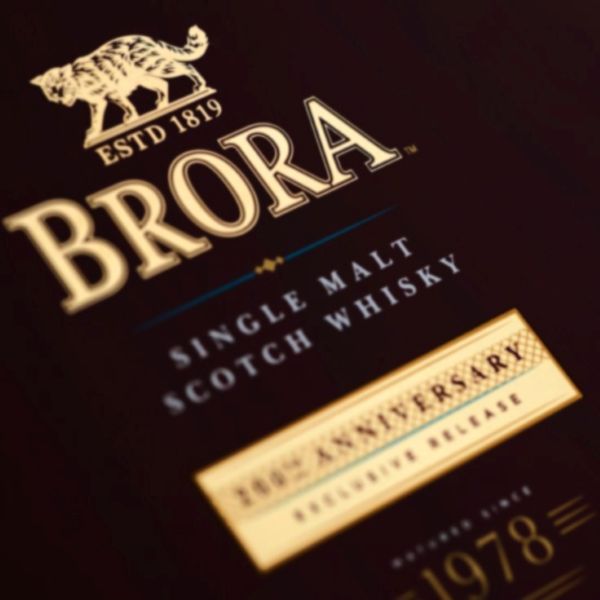The Brora distillery - a myth of the whisky world
The Scotch whisky industry is steeped in legend, but few distilleries have such a mystical status as Brora. The distillery, once known as Clynelish, later renamed and eventually closed, represents a rare combination of artisan tradition, historical significance and exceptional flavour. Today, its whiskies are highly sought after by collectors and connoisseurs, not only because of their limited availability, but also because of the unique story behind each bottle.
The beginnings: from Clynelish to Brora
The origins of the distillery date back to 1819, when the Clynelish Distillery was founded in the remote Sutherland region on the north-east coast of Scotland. The location was strategically chosen: The proximity to fresh water from the River Clynemilton and the availability of high-quality barley from the surrounding estates made the location ideal for whisky production. Clynelish developed into one of the most famous distilleries in the Highlands and was particularly appreciated for its full-bodied, slightly smoky style.
However, the true legend of Brora only began in the 1960s. Due to the increasing demand for whisky, the then owner, Distillers Company Limited (DCL, later part of Diageo), decided to build a new, larger distillery right next to the old Clynelish. The new plant was commissioned in 1967, while the original distillery initially continued to operate. However, things soon took a decisive turn for the worse: In the 1970s, a worldwide shortage of barley led to bottlenecks in whisky production. In order to secure capacity for popular brands such as Johnnie Walker, the old Clynelish was temporarily shut down in 1969.
But just three years later, in 1972, it was reopened - albeit under a new name: Brora. The reason for this was simple: to avoid confusion with the new Clynelish distillery, the old distillery was named after the nearby village of Brora. In the years that followed, it produced a distinctive whisky with a slightly smoky character that was clearly different from its predecessor.
The heyday and the sudden end
The 1970s and early 1980s were Brora's heyday. The distillery produced a heavier, peatier whisky than most other Highland distilleries, which made it particularly popular with blenders. But despite its quality, its fate was sealed: when the whisky crisis of the 1980s shook the industry and forced many distilleries to close, Brora was also affected. Production ceased in 1983, the gates were closed and the disused stills cooled for decades.
But unlike many other distilleries that fell into oblivion, the Brora legend lived on. The remaining barrels became sought-after rarities and their value increased exponentially over the years. Collectors and investors began to hunt for the last original bottlings, and auctions realised record prices for bottles from the distillery's heyday.
The renaissance: the reopening in 2021
For almost four decades, Brora was nothing more than a memory - until Diageo announced a sensation in 2017: the distillery was to be reopened. As part of a multi-million euro project that also included the revitalisation of the legendary Port Ellen distillery on Islay, restoration work began. In May 2021, the time had finally come: Brora resumed operations after 38 years of standstill.
The reopening was not just a marketing project, but a loving reconstruction of the old distillery. The new owners took meticulous care to preserve the original character - from the copper stills to the traditional production methods. Even the slightly smoky flavour for which Brora was once famous was to be restored.
Brora whisky: an incomparable character
What makes Brora whisky so special? Firstly, it is the rare combination of Highland elegance and light smoke that sets it apart from other malt whiskies. The original bottlings from the 1970s and early 1980s are legendary today - full-bodied, complex, with notes of honey, dried fruit, wax and a subtle hint of peat.
The new bottlings that have come onto the market since the reopening endeavour to preserve this style. Initial samples show that the master distillers place great importance on capturing the historical character while at the same time creating a modern interpretation.
Brora today: a symbol of whisky history
Today, Brora not only stands for outstanding whisky, but also for the preservation of the Scottish art of distilling. The distillery is a place of pilgrimage for whisky enthusiasts who are looking for the rare original bottlings from the pre-closure era or want to sample the new editions.
The story of Brora is one of rise, fall and rebirth - a reflection of the Scotch whisky industry itself. Their whiskies are not just drinks, but witnesses to a bygone era that is now slowly coming back to life. Anyone who owns a bottle of Brora today is not only holding an excellent malt in their hands, but also a piece of living history.
Conclusion
The Brora distillery is more than just a whisky distillery - it is a legend. From its humble beginnings as Clynelish, through its brief but formative phase as Brora, to its spectacular rebirth in the 21st century, it epitomises the fascination and magic of Scotch whisky. Its history is characterised by passion, craftsmanship and a dose of mystique that makes it one of the most coveted names in the world of single malt. Anyone who has ever been lucky enough to taste an original Brora will understand why this distillery leaves such an unforgettable impression.
The revitalisation
In 2017, there was a big twist in the Brora story. The company Diageo, owner of the distillery, announced that Brora would go back into production, sparking excitement among whisky lovers worldwide. After years of planning and restoration, the distillery reopened its doors to continue the tradition and inspire new generations of whisky connoisseurs.
The return of Brora is not only a revitalisation of the brand, but also a tribute to the craftsmanship of days gone by. New expressions of classic Brora whisky are being developed, combining both old recipes and modern techniques to preserve its authentic character.
Brora whisky today
Brora whiskies bottled since the revitalisation of the distillery have already been a great success. The new releases have gained in character while retaining the essence of the original. The bottlings are limited and fetch high prices on the market. Whisky fans are prepared to pay considerable sums to have the opportunity to taste a Brora and experience the history of this exceptional distillery.
One of the most remarkable bottlings is the Brora 40 year old, which offers a perfect balance between sweet and smoky flavours. The alcohol content of 52.2% is balanced by the smooth texture and complex flavours, making it a real pleasure to drink. Younger bottlings, such as the Brora 13 year old, also show the distillery's potential and offer a taste of future success.
Conclusion
Brora whisky not only epitomises remarkable craftsmanship, but also tells a story of tradition, setbacks and triumph. The distillery has stood the test of time and continues to fascinate whisky lovers around the world. With their return to production, Brora shows that they are able to both respect the roots of perfect whisky and find innovative ways to delight aficionados.
A glass of Brora whisky is more than just a drink - it's an experience that reflects the soul of the Highlands, making every sip a journey back in time. From time-honoured collectors to curious newcomers, everyone can enjoy the timeless appeal of Brora whisky. Next time you take a sip, remember: every drop tells a story - and the story of Brora is only just beginning.
1. key historical data
Founded: 1819 as "Clynelish Distillery" in Sutherland, Highlands
Renamed Brora in 1969 (following the closure of the old Clynelish distillery)
Closure: 1983 (in the wake of the whisky crisis)
Reopening: 2021 after a 38-year break (by Diageo)
2nd production characteristics
Whisky type: Single malt Scotch (lightly peated, 10-15 ppm)
Speciality: Combination of Highland character and a light smoky note
Water source: Clynemilton Burn (mineral-rich mountain water)
Production volume (historical): ~1 million litres/year
3. historical phases
| Period | Characteristics |
|---|---|
| 1819-1968 | Unpeated Highland style (as Clynelish) |
| 1969-1973 | Stronger peated (Islay replacement during Lagavulin renovation) |
| 1974-1983 | Slight smoky character (signature style) |
| 2021-today | Reconstructed original style |
4. special bottlings (Diageo Special Releases)
Brora 40 Years Old (2017, €5,500)
Brora Triptych (3x 38 Years Old, 2019, €30,000/set)
Brora 1982 37 Years Old (2020, €4,500)
Brora 12 Years Old (original bottlings 1970s)
5. sensory profile (classic Brora)
Colour: Gold to amber
Nose: Waxy notes, light peat smoke, exotic fruits
Flavour: Honey, citrus, light smoky spice, mineral
Finish: Long lasting, complex
6. market development & increase in value
1980s: Hardly noticed (€50-100 per bottle)
2000s: First rarity (€1,000+)
2010s: Cult status (€5,000-30,000)
Auction record: €35,000 for Brora 1972 (Cask #1)
7th reopening in 2021
Investment: £35 million
Production goal: Authentic replication of the original style
First new bottling: Brora 40 Years Old (2021, limited)
8. comparison with Clynelish
| Characteristic | Brora | Clynelish |
|---|---|---|
| Character | Slightly peated, more waxy | Unspoilt, maritime notes |
| Rarity | Extremely high | Regularly available |
| Price segment | €500-30.000 | €50-200 |
9 Cultural significance
Whisky connoisseurs: "The Holy Grail" among collectors
Pop culture: Status symbol in financial circles
Myth: Last bottlings from the 1970s are legendary
10. current situation (2024)
Production: 20-30 weeks/year
Cask storage: Use of historic warehouses
Future: Limited new bottlings planned






